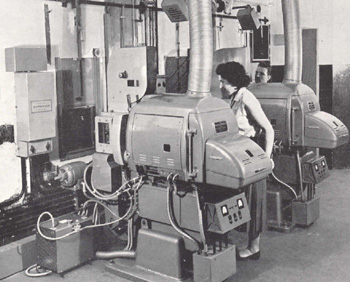How Todd's "80 Days" Was Presented at London Premiere |
This article first appeared in |
| Written by: The Ideal Kinema, July 11, 1957 | Issue 64 - March 2001 |
|
|
Further in 70mm reading: |
The Letter |
|
|
|
|
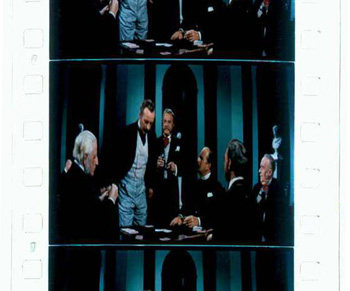 34mm
frames. Supplied by Dion Hanson 34mm
frames. Supplied by Dion HansonMike Todd called the process Cinema Stage. It was a anamorphic print with 1.56 squeeze giving us a ratio on screen of 2.2 to 1. The sound tracks were on 35mm mag. Tape with Selsyn synchronized follower heads. The tape had five tracks for the five channels behind the screen and one track for the effects speakers of which there were 34 round the auditorium. The effects track was integrated by the Perspecta system which split the track in three channels by means of a gating signal on the track. The signals were at 25 - 30 - 35 c.p.s. This very effective sound system worked from left, right and rear of auditorium. The screen channels were full stereo on both speak and music. Yours faithfully H. Handing Chief Projectionist |
|
Behind the scenes of Cinestage |
|
Gaumont-Kalee
Equipment chosen for London Premiere.
British
premiere of Michael Todd's mammoth film "Around the World in 80
Days", at the Astoria, Charing Cross Road, London, on Tuesday last
week, was in a new system of presentation, called Cinestage, which has been
evolved by technical experts in co-operation with Mr. Todd and, in addition
to the installation of special projection equipment, involved one of the
most comprehensive sound installations ever built in Great Britain. The film
was of course, originally shot in the Todd-AO process, but in the Cinestage
process a reduction print is used in conjunction with an anamorphic lens and
sound from a separate six-track magnetic film. Forty
Speakers Forty
SpeakersThe sound installation, which includes more than 40 auditorium effects speakers was carried out by GK-Kalee, Ltd. The projection equipment is linked to six individual Gaumonet-Kalee 21 amplifier channels, and sound from the screen is reproduced through five large Duosonic speaker assemblies. The effects channel incorporates a modified integrator unit and three separate power amplifiers feeding the effects speakers situated to the rear, above and to the sides of the audience. Projector adapted Special projection equipment was produced by Gaumont-Kalee for this Cinestage presentation. The equipment is based on the Gaumont-Kalee 21 projector, with water-cooled picture gate and adapted for the special film, and with Mole-Richardson Gaumont-Kalee high power arcs with their self contained water circulating system, producing screen illumination of the high order recommended by the British Standards Institution. Each projector is mounted on a tandem drive assembly linked by Selsyn power transmitter to a studio-type follower head capable of reproducing the recording on six-track film. Modification has been made to the lens holders to accommodate special lenses provided by Mr. Todd. The projector installation also included the provision of special stands giving a lower optical center. |
|
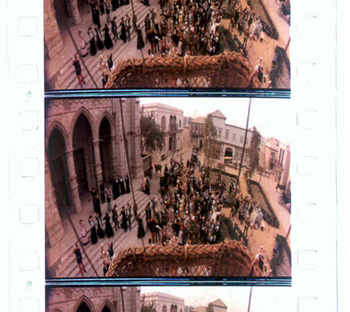 34mm
frames. Supplied by Dion Hanson 34mm
frames. Supplied by Dion HansonFor the audience at the premiere, there was a "new look" Astoria in several other ways. GB-Kalee supplied the special curved and electrically controlled curtain track shaped to the auditorium architectural cornice line. "Floating" Effect The track carries a pair of traverse draw curtains, valance, dress curtains, all in tan-coloured non-flame material and totaling 600 yards; the proscenium surfaces and surrounds are clad in heavy black wool serge. From the same company comes the Perlux screen, of maximum proportion to suit the auditorium, and screen frame, with the frame arranged to give a "floating" effect to the picture. GB-Kalee, Ltd. Also supplied carpeting in CMA rose and cherry floral patterns; and "Battleship" linoleum; while the foyer carpet was specially made to match the carpet already in the circle foyer and laid a few months ago by the same company. |
|
|
Before the showing Michael Todd announced that the process described above
would be used for the showing of the film in most cities of the world. |
|
|
|
|
 Two
Mole Richardson, Gaumont-Kalee high power arc lamps, with their
self-contained water circulating system, provided ample screen illumination.
Heat filtering of the intense light beam is controlled by a glass filter
which is cooled by a continues stream of air from its own blower motor. Two
Mole Richardson, Gaumont-Kalee high power arc lamps, with their
self-contained water circulating system, provided ample screen illumination.
Heat filtering of the intense light beam is controlled by a glass filter
which is cooled by a continues stream of air from its own blower motor.50000 Lumens at 130 amperes This outstanding figure was obtained with heat filter and lens in position with wide film aperture 1.34" x 1,06". 29000 Lumens with Cinestage aperrature 0.012" x 0.685". All readings taken with heatfilter and lens in position but without the projector shutter running. Magnetic Reproducers To handle the sound two film special Gaumont-Kalee cabinet type magnetic reproducers were installed. This type of reproducer is normally used in film studios as part of a re-recording chain. Each of the reproducers is fitted with a specially designed 6-track magnetic playback head and six magnetic playback amplifiers. Gaumont-Kalee. Amplifiers & Loudspeakers Five of the six output signals from the Magnetic Reproducers are fed via a special five-gang main volume control to Power Amplifiers Panels in the main racks, and thence to the five Gaumont-Kalee "Duosonic" stage loudspeaker assemblies, each speaker comprising a multi-celluar high-frequency horn with two pressure type treble units, and two 15 in. low frequency units mounted in direct flare baffle bins. The output of the sixth track of the magnetic film is fed into a modified Gaumont-Kalee Integrator Unit which, actuated by three superimposed control frequencies on the "effects track" feeds through a three-gang volume control into three type 1064 twin amplifier units. These outputs are used for driving the auditorium speakers, which are divided into three groups situated left, center rear and right, and are made to operate separately or together as required by the action of the film.  Perlux
screen Perlux
screenA Gaumont-Kalee "Perlux" screen of maximum proportions to suit the auditorium was installed with a screen frame designed to give a floating effect to the picture. The special "Perlux" surface, developed by the technologists in the Rank Precision Industries Group, gives perfect film enjoyment wherever patrons sit. Curtains & curved Track A curved and electrically controlled curtain track shaped to the auditorium cornice line was installed. The traverse draw curtains, valance and dress curtains are made of tan-colored non-flame material. Proscenium surfaces and surrounds are clad in heavy black wool serge. |
|
The Brochure |
|
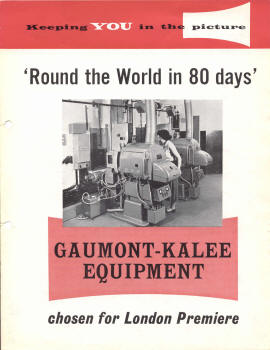 Page
1 Page
1 |
|
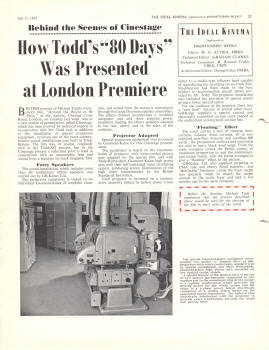 Page
2 Page
2 |
|
 Page
3 Page
3 |
|
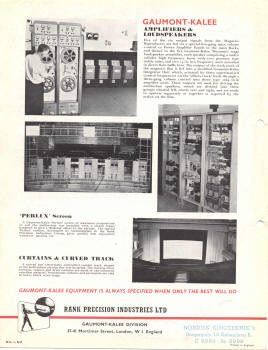 Page
4 Page
4 |
|
"80 Days" in Paris, France |
|
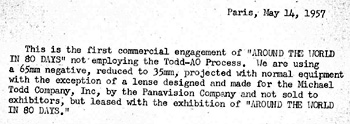 |
|
|
Go: back
- top - back issues Updated 21-01-24 |


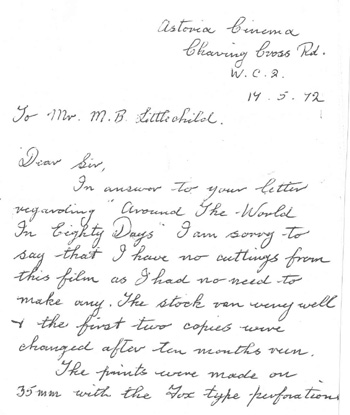 Astoria
Cinema
Astoria
Cinema
